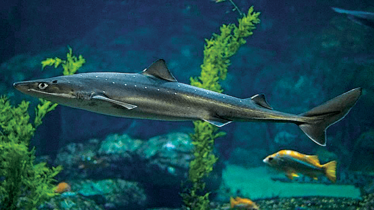Shark Attack
Could the unique properties of the shark immune system help us create biologics with more bite?

When scientist Caroline Barelle tells people that her research involves sharks they tend to jump to conclusions. “People often imagine I work next to a tank full of great whites – and that anyone who disagrees with our science becomes lunch!” she jokes. In fact, the sharks Barelle and her team work with are not man-eaters but spiny dogfish (Squalus acanthias), a common species off the coast of Scotland, where their lab is based. Though the diminutive dogfish may not be auditioning for a part in Jaws any time soon, the technology that Barelle and her colleagues are developing has dramatic potential.
Sharks have been attracting attention as a potential source of therapeutic proteins since the 1990s, when scientists found that, despite evolving some 450 million years ago, they have an adaptive immune system that is surprisingly similar to a mammalian one. The researchers identified an antibody-like molecule – immunoglobulin new antigen receptor (IgNAR) – that forms part of this adaptive response (1,2). While standard mammalian antibodies are made up of heavy and light chains, IgNARs have only heavy chains.

Squalus acanthias
Barelle first came across shark proteins in 2006 when she joined the antibody drug discovery biotech Haptogen. The company spotted the potential of these small antibody-like molecules for targeted therapies. The first thing to catch their eye was that the molecules are very small, less than a tenth of the size of human antibodies, and yet bind with great affinity to their target. They also have much greater stability than mammalian antibodies, thought to be a result of an interesting quirk of shark biology – their blood has a very high concentration of urea. The resulting high osmolarity prevents saltwater from dehydrating the animal, but also creates a harsh environment for proteins. The secret of how shark antibodies retain their stability in these conditions is being unraveled by researchers in Germany, who hope they can apply the knowledge to improve monoclonal antibody therapies (3).
Spin-out soloMERs
Convinced of their therapeutic value, Barelle has been working on shark proteins ever since, first at Haptogen, then at Wyeth and Pfizer, before joining the University of Aberdeen to head up their shark protein research program. But it wasn’t until now that she had the opportunity to bring together the whole IP portfolio into one company, focused solely on the technology.
The resulting company – Elasmogen Ltd, soon to be spun-out of the University of Aberdeen – will use humanized versions of the IgNAR variable domain (VNAR). The VNAR domain is produced either by immunizing the sharks and taking a blood sample or, to spare the sharks (and perhaps researchers’ fingers), assembled from a synthetic library of billions of shark VNARs created in the laboratory. The team then isolates VNAR domains against the target, selects the most effective, and humanizes it to produce a product suitable to be further developed for clinical use – a soloMER™.

“Antibodies are incredibly successful therapies that generate a lot of revenue”, says Barelle. “However, mammalian antibodies have a number of limitations. They are very large, complex molecules that cost a lot to make, so antibody therapies are typically expensive. The size also limits what tissues the therapy can penetrate and the type of targets they can go after.”
VNARs are single-chain domains, which makes them easier and cheaper to manufacture. Indeed, their small size and an unusual shape means they can reach targets that
Perfect fit
It was these special qualities of soloMERs that led Almac Discovery to approach Barelle’s team. “We knew about the work at Aberdeen and the Elasmogen team,” says Iain James, Vice President of Preclinical and Clinical Development at Almac. “We have a site-directed coupling technology for proteins that we are interested in using for antibody–drug conjugate (ADC)-like approaches, and this seemed like a great match,” he adds. Almac Discovery is focused on anticancer therapies, and the group was hunting for technologies that would allow better penetration of protein conjugates into solid tumors.

The collaboration was equally attractive to Elasmogen, who are looking for partners with complimentary technology to bring soloMERs into the clinic. Almac’s proprietary coupling technology joins small-molecule drugs (in this case cytotoxic anticancer therapies) exclusively to the C terminal end of the protein, rather than the random coupling more commonly seen in antibody–drug conjugates. “We will know exactly where the cytotoxic is coupled, and how many cytotoxics are coupled to each protein. That way we can be in a lot more control of the manufacturing process and we have a much better defined product and possibly a better side-effect profile,” says James.
The initial stages – production of the protein and screening for the most promising VNAR domains – will be carried out in Elasmogen’s lab in Aberdeen. They will send the candidate VNAR domains to Almac Discovery, based in Northern Ireland, who will further develop the proteins and be responsible for pre-clinical and clinical development.
But the potential for soloMERs goes beyond cancer therapies, according to Barelle. Their extreme stability means that they could survive the harsh environment of the gastrointestinal tract (even after boiling, the team found the soloMERs would still bind to their target). An oral formulation for biologics is somewhat of a holy grail right now, and the team are keen to investigate this further. Another avenue to be explored is delivery to the eye. “Current ocular antibody therapies may involve regular injections into the eye – we hope that the small size of soloMERs could make them suitable for topical or site-specific application,” says Barelle.
To find out what soloMERs are capable of, the team at Aberdeen are on the lookout for further collaborations with pharmas or biotechs developing compatible technologies.
Camels and convergence
Sharks are not the only animals whose immune molecules are inspiring interest. Camelids (a group that includes camels, llamas and alpacas) also produce single-domain heavy-chain antibodies, in addition to the usual mammalian immunoglobulins. “I find it fascinating as a scientist that such diverse animals have evolved such similar molecules as part of their adaptive immune response,” says Barelle. “It’s a great example of convergent evolution.”
What do sharks and camels have in common that means they independently evolved stable, single-domain antibodies? We can’t know for sure, but Barelle speculates that an extreme environment may be a factor – after all, many camelids face an inhospitable desert environment, while sharks must overcome the dehydrating effect of salt water.
Camelid antibodies are being commercialized for the clinic by Belgian company Ablynx in collaboration with a host of big pharma companies, with several programs already at clinical stage, a success that Barelle’s team finds encouraging. Although there are some similarities with the single-domain antibodies of camelids, VNARs are quite distinct – they have more binding loops, are smaller and, importantly, are phylogenetically distinct from antibodies, which the Aberdeen team hope will make them even more clinically effective and commercially attractive.
“It’s been a very exciting time for me over the last few years,” says Barelle. “I have moved from being a director of science to building a business and setting up new partnerships, like the one with Almac. To be even a small part of developing a drug that gets all the way into the clinic is immensely rewarding and I look forward to starting Elasmogen as a fully independent company in the coming months.”
From the Deep…
Shark VNAR domains were discovered by chance and scientists believe that many more potential therapies are hiding in the animal kingdom. Given that 95 percent of the earth’s oceans have yet to be explored, who knows what life-saving compounds could be lurking in their depths. Here’s just a few secrets the sea has given up so far…
Ocean oncology
Lissoclinum patella, commonly known as the sea squirt, could provide a new class of drugs in the fight against cancer. It’s not the most glamorous of marine creatures, but the symbiotic microbes hosted by the sea squirt have been found to contain compounds, known as patellamides, active against a number of cancers. Another species of sea squirt was the original source for the chemotherapy drug trabectedin, now being used to treat soft tissue sarcomas.
Ouch!
A cone snail can cause a painful sting to unlucky humans who cross its path. But it seems that the venom also contains a number of analgesic molecules, which could have unique benefits for patients suffering chronic pain. Biochemist David Craik told a meeting of the American Chemical Society that a compound based on the venom was up to 100 times more potent than morphine in a rodent model, with no evidence of addiction.
Caring coral
Coral reefs have been a rich source of medicines for decades, with azidothymidine for HIV and anticancer agent cytarabine just two of the drugs that have their origins in these fragile ecosystems. A type of soft coral, gorgonion, produces several compounds with promising anti-inflammatory properties, with applications both in medicine and cosmetic skin creams.
- S. Greenberg et al, “A New Antigen Receptor Gene Family That Undergoes Rearrangement and Extensive Somatic Diversification in Sharks”, Nature 374(6518), 168–173 (1995).
- K. H. Roux et al., “Structural Analysis of the Nurse Shark (New) Antigen Receptor (NAR): Molecular Convergence of NAR and Unusual Mammalian Immunoglobulins”, PNAS 95(20), 11804–11809 (1998).
- M. J. Feige et al., “The Structural Analysis of Shark IgNAR Antibodies Reveals Evolutionary Principles of Immunoglobulins”, PNAS 111 (22), 8155-8160 (2014).

As an Editor at Texere, I’m working closely with our audience to create vibrant, engaging content that reflects the hard work and passion that goes into bringing new medicines to market. I got my start in biomedical publishing as a commissioning editor for healthcare journals and have spent my career covering everything from early-stage research to clinical medicine, so I know my way around. And I can’t think of a more interesting, challenging or important area to be working in.



















